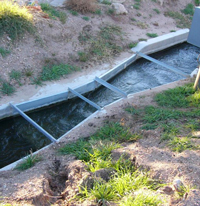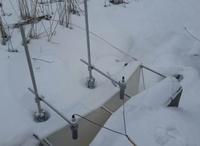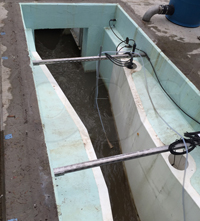Submerged Flow
 For a Parshall Flume to operate as designed, the flume's discharge must be free and not restricted by downstream conditions. When downstream resistance to flow increases above a certain point and now reduces the upstream velocity through the flume, a backwater effect develops. The transition from free, unrestricted flow to slowed velocity / backwater one is known as the submergence transition (St).
For a Parshall Flume to operate as designed, the flume's discharge must be free and not restricted by downstream conditions. When downstream resistance to flow increases above a certain point and now reduces the upstream velocity through the flume, a backwater effect develops. The transition from free, unrestricted flow to slowed velocity / backwater one is known as the submergence transition (St).
It is important to remember that although a Parshall Flume may have initially designed for free-flow at an installation, changes in the downstream hydraulics can submerge the flume. These changes are typically due to downstream vegetation, sediment deposit, added hydraulic structures, or channel reconfiguration.
Don't assume that a once free-flowing Parshall will always be a free-flowing Parshall
Submergence Transition
The submergence transition is the ratio of the secondary point of measurement depth (Hb – located in the Parshall Flume's throat) to the depth at the primary point of measurement (Ha – located in the converging section of the flume).
For Parshall Flumes, the submergence transition increases as the flume size increases.
The chart below (per ASTM D1941) provides the submergence transition for Parshall flumes as:
|
1-3 inch Parshall |
50% |
|
6 inch Parshall |
60% |
|
1-8 foot Parshall |
70% |
|
10-50 foot Parshall |
80% |
Submerged Flow Equation
When the flow passes from a free to a submerged state (through the submergence transition), the free-flow equation can no longer be used. A new and considerably more complex submerged flow equation is needed, as the free-flow equation will increasing overstate the flow as the degree of submergence increases.
In addition to a different equation being used, a second level measurement (Hb) must also be taken to determine the level of submergence – adding to the cost and complexity.
Secondary Point of Measurement (Hb)
 The secondary point of measurement (Hb) is located in the throat of the Parshall, just upstream of where throat meets the diverging section (outlet). The zero elevation for Hb is the same as as for Ha , the floor of the converging section.
The secondary point of measurement (Hb) is located in the throat of the Parshall, just upstream of where throat meets the diverging section (outlet). The zero elevation for Hb is the same as as for Ha , the floor of the converging section.
As the submergence in the flume increases, small measurement errors determining the level become critical.
The difficulty in measuring Hb effectively caps corrections at 95% under the best of conditions. Under field conditions, 90% is considered to be the upper end of correctable flow.
Aid to Measuring Hb

The flow through the throat of a Parshall Flume can be quite turbulent – making an accurate determination of Hb difficult. A stilling well can be used to make measuring Hb easier. Stilling wells reduce surface turbulence and dampen sudden changes in water level, making it easier to measure Hb.
Keep in mind that stilling wells are not suitable for sanitary flows. Sediments and solids drop out of the flow and collect in the bottom of the stilling well (and potentially clog the inlet port).
Benefits of Submerged Flow
While Openchannelflow usually recommends designing Parshall Flume installations for free-flow, there are some advantages to designing for submerged flow.
The installation / retrofit costs are usually less for submerged flow installations. There isn't a need to elevate the flume in the channel, build up the upstream channel banks, or modify the downstream channel floor.


